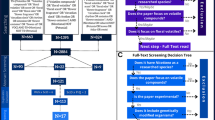Abstract
The reproductive biology of the genusDamasonium was studied in cultivation and in nature. A correlation was shown between flowering time and latitude. All species are self-compatible but the N. American member of the genus (D. californicum) is strongly protandrous and probably experiences high levels of outcrossing in nature. In the European taxa the stamens and the stigmas mature simultaneously but the levels of inbreeding appear to be greater in the southern species (D. bourgeai, D. polyspermum) than in the northern (tetraploid) speciesD. alisma. The Australian memberD. minus resembles the southern European species in being strongly autogamous and bud-pollination was shown to occur. Floral morphology, stigma exertion, pollen/ovule (P/O) ratio and seed weight each show a strong correlation with the degree of autogamy. Vegetative reproduction occurs only inD. californicum andD. alisma through the production of corm-buds. This study suggests that autogamy inDamasonium is accompanied by a shift in resource allocation from male (pollen) toward female (seed) function. However, further studies are required to assess the quality of seeds and their survivorship in nature.
Similar content being viewed by others
References
Aston, H. I., 1973: Aquatic Plants of Australia. — Melbourne: Univ. Press.
Baker, H. G., 1972: Seed weight in relation to environmental conditions in California. — Ecology53, 997–1010.
Beadle, N. C. W., 1981: The Vegetation of Australia. — Stuttgart, New York: G. Fischer.
Cruden, R. W., 1977: Pollen-ovule ratios: a conservative indicator of breeding systems in flowering plants. — Evolution31, 32–46.
—, Miller-Ward, S., 1981: Pollen-ovule ratio, pollen size, and the ratio of stigmatic area to pollen-bearing area of the pollinator: an hypothesis. — Evolution35, 964–974.
Faegri, K., Van der Pijl, L., 1979: The Principles of Pollination Ecology. — Oxford: Pergamon Press.
Garnock-Jones, P. J., 1981: Changes of adaptation from entomophily to autogamy inParahebe linifolia (Scrophulariaceae). — Pl. Syst. Evol.137, 195–201.
Grant, V., 1963: The Origin of Adaptations. — New York: Columbia Univ. Press.
Jain, S. K., 1976: The evolution of inbreeding in plants. — Ann. Rev. Ecol. Syst.7, 469–495.
Martin, F. W., 1959: Staining and observing pollen tubes in the style by means of fluorescence. — Stain Tech.34, 125–128.
Moore, D. M., Lewis, W. H., 1965: The evolution of self pollination inClarkia xantiana. — Evolution19, 104–114.
Ornduff, R., 1969: Reproductive biology in relation to systematics. — Taxon18, 121–133.
Primack, R. P., 1978: Regulation of seed yield inPlantago. — J. Ecol.66, 835–849.
Queller, D. C., 1984: Pollen-ovule ratios and hermaphrodite sexual allocation strategies. — Evolution38, 1148–1151.
Raven, P. H., 1976: Systematics and plant population biology. — Syst. Bot.1, 284–316.
Schotsman, H. D., 1970: Contribution à la caryologie des angiospermes de la Sologne et du Val de Loire. II. — Bull. Cent. Études Rech. Sci. Biarritz8, 199–255.
Waller, D. M., 1979: The relative costs of self- and cross-fertilized seeds inImpatiens capensis (Balsaminaceae). — Amer. J. Bot.66, 313–320.
Wells, S. H., 1979: Self fertilization: advantageous or deleterious? — Evolution33, 252–255.
Willson, M. F., 1983: Plant Reproductive Ecology. — New York: Wiley.
Wright, S., 1940: Breeding structure of populations in relation to speciation. — Amer. Naturalist74, 232–248.
Wyatt, R., 1984: The evolution of self-pollination in granite outcrop species ofArenaria (Caryophyllaceae). I. Morphological correlates. — Evolution38, 804–816.
Author information
Authors and Affiliations
Rights and permissions
About this article
Cite this article
Vuille, FL. Reproductive biology of the genusDamasonium (Alismataceae) . Pl Syst Evol 157, 63–71 (1987). https://doi.org/10.1007/BF00939181
Received:
Issue Date:
DOI: https://doi.org/10.1007/BF00939181




